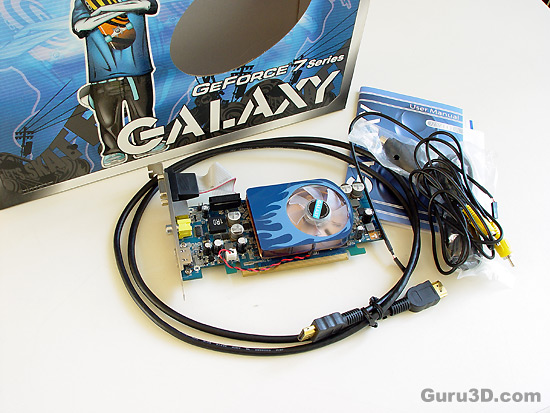Page 2
Let's talk about the graphics card itself first a little before we dive into the HDMI controversy.
The silicon powering this graphics card comes from NVIDIA and was developed under codename G73, the actual 7600 GS chip was made with a 90nm fabrication process. For a mid-range product it has a rather large transistor count, actually no less than 177 million transistors can be found on both the GeForce 7600 GS and GT silicon.
You might ask... what's different on this Galaxy card compared to the regular GeForce 7600 GS and GT then? It's a valid question and allow me to answer it.
Get this, 12 pixel pipelines running at a 575 MHz frequency; for your information a default GS is clocked at at 400 MHz. It is packed with five active vertex processors which bind to eight ROPs. The memory however is still 128-bit whereas I hoped it would have been boosted to 256-bit.
The good thing about the memory on this card is that it's clocked fast though...
1.2ns gDDR3 memory at 1500 MHz (2x747) which is higher than the 7600 GT and way higher than the standard reference GS. That is looking to be quite okay in my eyes.
Judging from the specifications this 110 EUR product should be able to compete with the middle segment of current mid-range graphics cards such as the 7600GT very well.
Since it's a Series 7 product you can expect a dual-link connector (through HDMI) for extremely high resolution gaming up-to 2560x1600 (XHD as the industry would love to call that = Extreme High Definition) and all the sweetness in the form of HDR support and that finally important Shader Model 3.
Allow me to place everything in a chart to understand the technology behind the 7600 GS a tad better:
Please focus on the chart below where I cite the more important specifications. Highlighted in blue you'll notice the Galaxy products specs.
|
NVIDIA GeForce 6 & 7 Product Lineup Specifications | ||||||
|
Product Name |
# pixel processors |
# vertex processors |
Bus width |
Memory Type/Amount |
GPU Speed |
RAM Speed |
| GeForce 7900 GTX | 24 | 8 | 256-bit | GDDR3/512MB | 650-700MHz | 1600 MHz |
| GeForce 7900 GT | 24 | 8 | 256-bit | GDDR3/256MB | 450MHz | 1320 MHz |
| GeForce 7800 GTX | 24 | 8 | 256-bit | GDDR3/512MB | 560MHz | 1600 MHz |
| GeForce 7800 GTX | 24 | 8 | 256-bit | GDDR3/256MB | 430MHz | 1200MHz |
| GeForce 7800 GT | 20 | 7 | 256-bit | GDDR3/256MB | 400MHz | 1000MHz |
| GeForce 7800 GS | 16 | 6 | 256-bit | GDDR3/256MB | 375MHz | 1200MHz |
| GeForce 7600 GT | 12 | 5 | 128-bit | GDDR3/256MB | 560MHz | 1400MHz |
| GeForce 7600 GS | 12 | 5 | 128-bit | GDDR3/256MB | 575MHz | 1500MHz |
| GeForce 7600 GS | 12 | 5 | 128-bit | GDDR2/256MB | 400MHz | 800MHz |
|
GeForce 6800 Ultra |
16 |
6 |
256-bit |
GDDR3/256MB |
400MHz |
1100MHz |
|
GeForce 6800 GT |
16 |
6 |
256-bit |
GDDR3/256MB |
350MHz |
1000MHz |
| GeForce 6800 GS PCX | 12 | 5 | 256-bit | GDDR3/128/256MB | 425MHz | 1000MHz |
| GeForce 6800 GS AGP | 12 | 5 | 256-bit | GDDR3/128/256MB | 350MHz | 1000MHz |
|
GeForce 6800 |
12 |
5 |
256-bit |
GDDR/128MB |
325MHz |
700MHz |
|
GeForce 6800 LE |
8 |
4 |
256-bit |
GDDR/128MB |
320MHz |
700MHz |
| GeForce 6600 GT | 8 | 3 | 128-bit | GDDR3/128/256MB | 500MHz | 1000MHz |
| GeForce 6600 | 8 | 3 | 128-bit | GDDR/128MB | 300MHz | 275(550) |
| GeForce 6200 | 4 | 3 | 64/128-bit | GDDR/128MB/256MB | 300MHz | 275(550) |
As you can see Galaxy did some outstanding stuff with this GS, it has much faster clocks on both memory and core which brings the product VERY close to the slightly more expensive 7600 GT.
The bundle
Now we always mention what candy you get included in the box. Obviously a graphics card with the faster memory, faster core, HDMI connector, reasonably good cooling solution and furthermore everything to get you connected.
Included are:
-
GeForce 7600 GS / HDMI
-
HDMI cable
-
Svideo to HD analog bracket
-
composite cable
-
SPDIF audio pass through cable
-
driver CD
-
manual

Yes, very basic. But then again... at 110 EUR you do receive a HDMI cable which is great value.
HDTV - HDMI - HDCP - HD-Ready terminology explained
Okay, let's have a brief chat about what exactly verbs like HDMI and HDCP mean. The HDTV market continues to heat up, and who has not heard about terms like HD Ready?
Let's run through some terms. HDTV stands for High Definition Television, the current image standard is know as Standard Definition. The high definition format uses upto 1080 lines to make up the picture you see on your TV compared to 576 for the current standard, HD will also be broadcast in widescreen 16:9 format rather than the conventional 4:3 format. This will make for a truly cinematic experience.
Next page, if you please...
